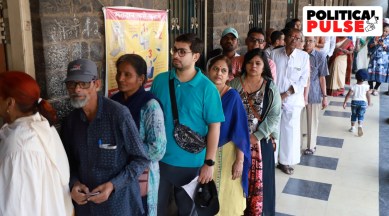Simultaneous polls past and present: What the numbers tell us
At present, only Andhra Pradesh, Odisha, Arunachal Pradesh, and Sikkim hold simultaneous elections. In three of these, regional parties hold sway. So, will holding synchronised elections help national parties like the BJP?

The government on Saturday revealed the eight-member committee led by former President Ram Nath Kovind that will “examine and make recommendations for holding simultaneous elections” to the Lok Sabha, state Assemblies, municipalities and panchayats.
The proponents of the move say simultaneous polls will reduce expenses associated with holding elections and reduce the amount of development time lost during campaigning. But one argument against simultaneous elections is that they are likely to favour larger parties with a national presence, parties with more resources that can dominate campaigning and push regional parties and local issues to the side. Smaller parties with fewer resources are likely to struggle in such a scenario.
monthly limit of free stories.
with an Express account.
A 2015 study by independent think tank IDFC Institute found that between 1999 and 2014, there was a “77% chance that the winning political party or alliance will win both the Lok Sabha and Assembly elections in that state when held simultaneously”. If the elections are held even six months apart, the figure drops to 61%.
The first four elections
From the first elections in 1952 until 1967, elections were held simultaneously across the country. But since the Lok Sabha and Assemblies can be dissolved before their tenures end, over time the state and national elections became misaligned.
In the early years, the Congress was the dominant party at the Centre and in the states. In 1957, Kerala elected the first non-Congress state government when the Communist Party of India came to power. It was the only state in which a regional party won more Lok Sabha and Assembly seats than the Congress.
But Kerala’s Assembly was also the first to be dissolved in 1959 after being placed under President’s Rule, breaking the synchronised cycle of elections. Fresh elections were held in 1960. In the 1965 elections, after the government completed its tenure, no party was able to form the government. So, the state was again placed under President’s Rule until polls were held simultaneously with the Lok Sabha in 1967.
In the 1967 Lok Sabha elections, though the Congress won a majority of seats, it suffered major setbacks in state Assembly polls in Bihar, Uttar Pradesh, Rajasthan, Punjab, West Bengal, Odisha, Tamil Nadu, and Kerala. Instability in these Assemblies led to widespread defections and, eventually, the dissolution of eight state governments. When new elections were held in these states, they were no longer aligned with the Lok Sabha polls.
Simultaneous elections or not, the ruling party at the Centre returned to power every year until 1977 when the Janata Party coalition defeated Indira Gandhi’s Congress following the end of Emergency.
Election results for the first five Lok Sabha elections after Independence show that the Congress comfortably won every poll with at least 40% of the vote share, despite being challenged by new parties and breakaway factions. Until the post-Emergency era, barring a handful of states, the Congress also won most Assembly elections. In 1971, though several state polls were no longer aligned with the Lok Sabha, the Congress won in a landslide and even improved its vote share from 1967.
How recent simultaneous polls played out
Since 1967, further dissolutions, both at the Centre and in the states, have resulted in a major election being held almost every few months. However, only four states now hold simultaneous elections with the Lok Sabha — Andhra Pradesh, Odisha, Arunachal Pradesh, and Sikkim.
Of these four states, only Arunachal Pradesh favoured national parties. In 2019, the BJP won both its Lok Sabha seats with a 58.2% vote share and 41 of its 60 Assembly seats with a 50.9% vote share. The Congress’s vote shares, too, were similar in both elections – 20.7% in the Lok Sabha and 16.9% in the Assembly. It was a similar story, but in reverse, in 2014. The Congress won with 49.5% of the votes while the BJP’s vote share was 30.9%. The Lok Sabha tally was one all.
In Andhra Pradesh, Odisha, and Sikkim, regional parties hold considerably more sway than national parties though some like the Biju Janata Dal (BJD) and the YSR Congress Party (YSRCP) — the ruling parties in Odisha and Andhra Pradesh — are aligned with the BJP on most issues in Parliament.
Results in both 2019 and 2014 show that voters tend to choose the same party, national or regional, at the Centre and in the state in simultaneous elections. In Andhra, Odisha and Sikkim, the BJP and the Congress were minor players for both the Lok Sabha and Assembly polls, winning few to no seats, in 2019 and 2014.
But voter turnout data paints an interesting picture. All four states with simultaneous elections had higher turnout rates than the national average. While national turnout for Lok Sabha polls ranged between 58% in 2004 and 67% in 2019, these states saw significantly higher turnout for both Lok Sabha and Assembly polls. In 2019, there was a double-digit difference in turnout rates between the national average and Sikkim’s figures for both elections.